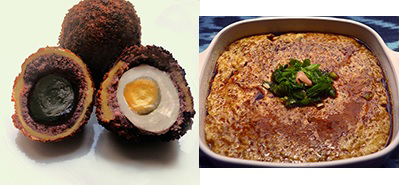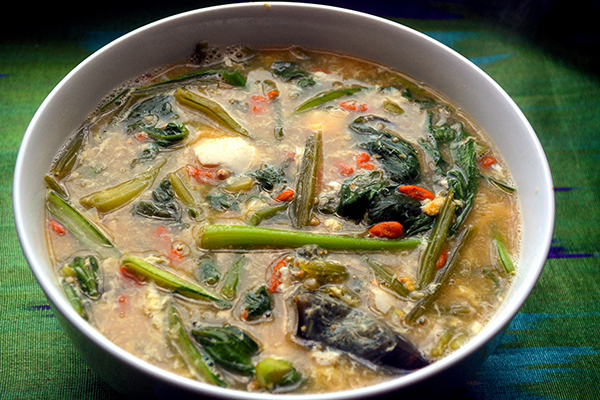We’ve come to the end of our current exploration of Century Eggs – from making them from scratch, to mixing them with other ingredients and preparing dishes with them. This is recipe number ten of ten, and what a nice way to end a series it is. This is a soup – a homestyle recipe – that is enjoyed across China as well as in East and Southeast Asia. It uses Chinese Spinach, also called Yin Choi or Yin Tsai, to flavor a delicate, egg-drop style soup that is savory, delicious and filling.
The soup is also very quick to make, and takes about 20 minutes from the beginning of preparation to serving. It could be a bit more time if you chose to let the wolfberries stew in the chicken broth a bit, for a sweeter soup.
The Chinese Spinach or Yin Choi (Yin Tsai) is really a form of edible amaranth that comes in a variety of shapes and colors. My favorite is the type with a purple blush up the center of the otherwise green leaf, it makes for a beautiful presentation. Alas, this form is not always available around here, so for this dish, I used one of the all-green varietals. Yin Choi is delicious, and very nutritious. It is extremely high in Vitamin A (2770 IU/100g) and is also a good source of Vitamin C, calcium, potassium, and iron. Other greens are sometimes substituted for amaranth, and it is not uncommon to see the thin, spear-like leaves of water spinach used in variations of this dish.

In plain English, this means that the atropine in goji berries binds at the receptor sites used by the neurotransmitter acetylcholine, and dilates the pupils, increases heart rate, and reduces salivation and other secretions. In much larger doses than those provided by goji berries, atropine is used as an antidote to a number of toxins, including organophosphate insecticides and some chemical nerve agents such as tabun, sarin, VX and soman.
So you have a recipe using Century Eggs that make a delicious, medicinal soup that also protects you from chemical weapons. Does it get any better than this?
Spinach Soup with Century Eggs
Ingredients
1 pound Chinese Spinach (also called yin choi or yin tsai)
3 cups chicken broth
1 cup plus 1/3 cup water
3 tablespoons wolfberries
1-2 teaspoons light soy sauce
2-3 teaspoons garlic, minced
1 century egg, quartered
1 cooked salted egg, quartered
1 tablespoon cornstarch
1/3 cup water
1 teaspoon salt
1-2 teaspoons freshly ground white pepper
1 egg, beaten
1 teaspoon of sesame oil (or to taste)
Directions
Wash spinach and drain well. Separate leaves from stalks, and cut stalks into 2-3 inch sections.
In a large saucepan, bring chicken stock and 1 cup of water to a rolling boil, and add the wolfberries. Lower heat to a low simmer and cook for 2-3 minutes. (If you desire a stronger wolfberry flavor, remove from heat and cover the pot to allow berries to stew a bit.)
Return broth to a boil and add soy sauce and garlic. Then add the spinach stalks. Cover saucepan and boil for about 2-3 minutes. Pour cornstarch and water mixture into pan a bit at a time, stirring constantly until desired thickness is achieved.
Add the leaves of the Chinese Spinach and after the leaves begin to wilt, add the sliced century and salted eggs. Boil for about 1 minute Add salt and pepper.
Turn off heat and slowly pour in the beaten egg and stirring vigorously to thread the egg as you do. Add sesame oil, and mix. Serve immediately with extra sesame oil and other condiments as desired.
Variations: There are many variations of this dish. One of the most popular is a spinach in sauce that can be achieved by reducing the chicken broth and water by half and adjusting the seasonings accordingly (reduce soy, reduce pepper). One can also omit the garlic and add a couple of teaspoons of sugar to emphasize the goji berries in a less savory broth. The dish can also be made suitable for vegetarians (assuming they eat eggs) if a strong vegetable broth is substituted for the chicken broth.
_____
I really like this recipe. It is as comforting and homey as an egg-flower soup can be with the added flavor of the amaranth, goji berries, and of course, the Century Eggs. In truth, the Century Eggs provide something of a foil to the rest of the soup with mouthful blasts of lightly sour, pungent flavor within the delicate broth. It is indeed good to the last, but the white pepper has a tendency to aggregate at the bottom, so be careful of those last couple of spoon fulls – they might pack a wallop of spice.

There are many other ways to prepare pidan or Century Eggs, but the ones presented here are my favorites. They can be coated with fish, shrimp or squid paste and deep fried. My favorite form of this recipe is found most frequently in Thailand where they flavor the fish paste around the eggs with lots of Thai Basil. There are also a whole family of steamed Century Eggs recipes – usually coupling the pidan with salted eggs or occasionally with tea eggs or the intriguing soy-soaked iron eggs in a ground of regular chicken or duck eggs.
I hope you’ve enjoyed this exploration of Century Eggs, and that you try (and like) some of the recipes presented. If you were familiar with and like Century Eggs, I hope that these recipes give you some great ways to enjoy the eggs. If you were unfamiliar with the eggs to start, I hope also that the recipes and discussion gives you some perspective when viewing all of those “most horrible food ever,” videos out there on the internet of young men proving their bravery by eating a Century Egg. They really aren’t any worse than a bit of strong cheese, and when prepared correctly, their flavor brings a delicious savoriness to a wide variety of dishes. It’s been an interesting journey for me, and as always, I am grateful for having the opportunity to share it with you. (All words and photos by Laura Kelley.)

